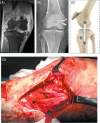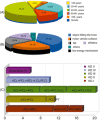Surgical management of the multiple-ligament injured knee: a case series from Chongqing, China and review of published reports
- PMID: 24254446
- PMCID: PMC6583531
- DOI: 10.1111/os.12077
Surgical management of the multiple-ligament injured knee: a case series from Chongqing, China and review of published reports
Abstract
Objective: The correct management of multiple-ligament injured knees (MLIKs) remains controversial. This study aimed to summarize the epidemiological features and short-term results of patients treated in our department.
Methods: Sixty-six patients diagnosed with MLIKs from 2009 to 2011 were enrolled. Relevant patient characteristics and clinical variables were analyzed to characterize the epidemiology. A surgical algorithm based on a knee dislocation classification system and postoperative rating scales, including Lysholm and Tegner rating, as well as joint mobility, stability and radiography were collected for functional evaluation at 2.5-year follow-up.
Results: The epidemiological profile demonstrated that 30- to 50-year-old men were at the highest risk. The primary causes were vehicle accidents and falls and most common injury type cruciate combined collateral ligament injuries. Final follow-up analysis comparing operative versus conservative management and surgically treated mild versus severe MLIKs showed significant differences in Lysholm and Tegner scale scores, as well as knee mobility and stability.
Conclusion: The therapeutic outcome of MLIKs depends on various clinical variables and a surgical algorithm. Satisfactory restoration of function was acquired in the majority of our surgically treated MLIK cases; however, most patients had not achieved their pre-injury activity levels by the follow-up endpoint.
Keywords: Follow-up; Knee; Ligament injury; Reconstruction.
© 2013 Chinese Orthopaedic Association and Wiley Publishing Asia Pty Ltd.
Figures







References
-
- Fanelli GC. The multiple ligament injured (dislocated) knee. J Knee Surg, 2012, 25: 261. - PubMed
-
- Edwards GA, Sarasin SM, Davies AP. Dislocation of the knee: an epidemic in waiting? J Emerg Med, 2013, 44: 68–71. - PubMed
-
- Wang ZG. Current situation and future of road traffic injury (Chin). Chuangshang Wai Ke Zazhi, 2011, 13: 193–196.
-
- Fanelli GC, Stannard JP, Stuart MJ, et al Management of complex knee ligament injuries. J Bone Joint Surg Am, 2010, 92: 2235–2246. - PubMed
-
- Van Tongel A, MacDonald PB. How I manage the multiple‐ligament injured knee. Oper Tech Sports Med, 2010, 18: 245–249.
Publication types
MeSH terms
LinkOut - more resources
Full Text Sources
Other Literature Sources
Medical

